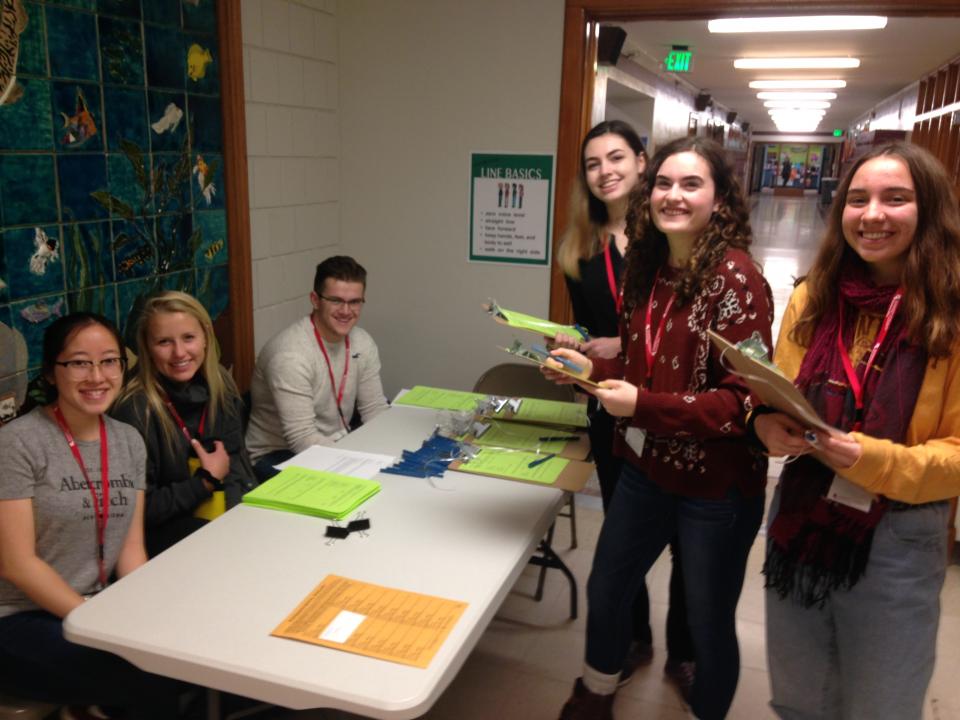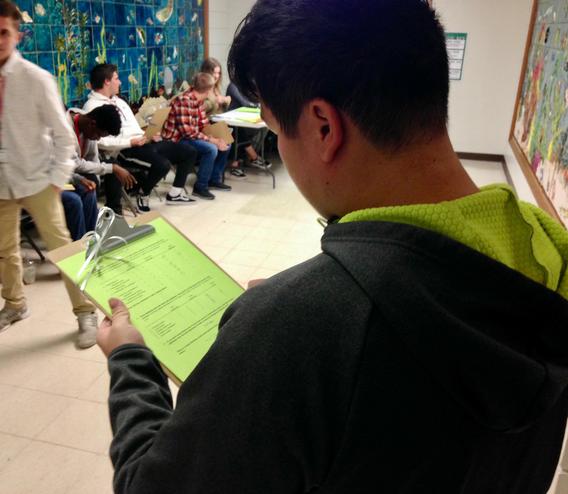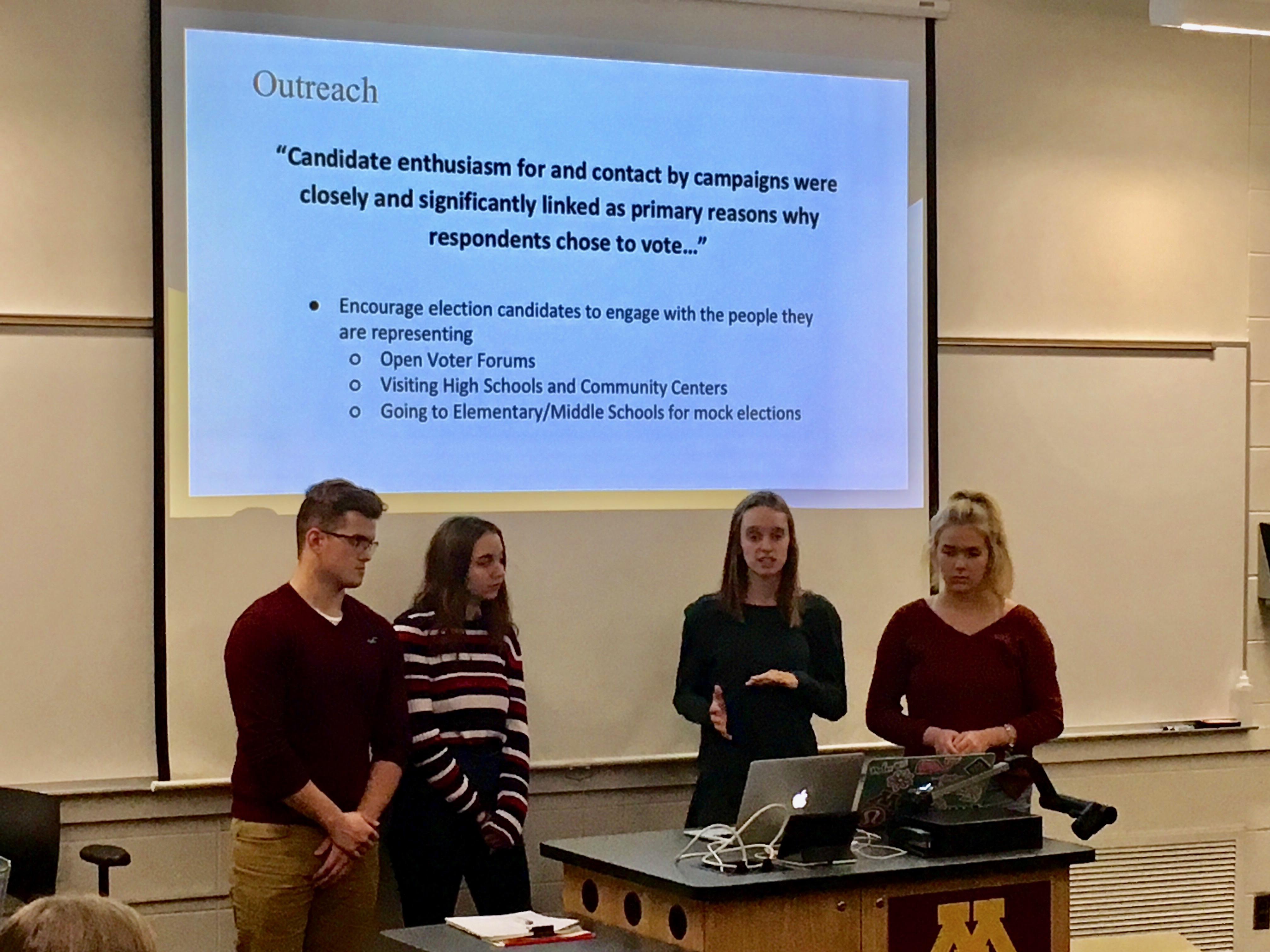On election day this November, students from a University of Minnesota freshman seminar, POLS 1914: Young Adult Political Action, spent more time at the polls than usual. During the early-morning voting rush and throughout much of Election Day, students were posted at Jackson Elementary School in Saint Paul’s Frogtown neighborhood to engage voters about barriers to voting and what motivates them in civic participation.
Precinct 1-9, which encompasses part of Frogtown, is a young and diverse precinct with a large population of residents of color. Asian Americans represent the largest racial and ethnic group in the precinct. According to a 2017 report, it’s also a precinct with historical patterns of persistently low voter turnout, especially among young adults.
Ramsey County Elections staff Joe Mansky and Dave Triplett have worked with students this semester through the County’s partnership with the Resilient Communities Project, seeking help to better understand why young adults’ voting rates are so low. Mansky and Triplett, who have observed the chronic problem of low turnout first-hand in recent elections, discussed the issues with students at a class visit in October. At the time, Triplett noted that “80,000 residents are sitting out elections in Ramsey County.” Coupled with the number of tightly contested state and local elections in Minnesota in recent years, voter turnout is drawing more scrutiny and attention. Mansky, Ramsey County’s Elections Manager, told students, “We want you to talk to your peers in St. Paul to figure out why these individuals aren’t voting.”
A Perfect Match
POLS 1914, taught by Dr. Scott Abernathy. marks the first Political Science course at the University to adopt an RCP project as part of the course curriculum. And students seem to be responding well to the experience. First-year student Kailin Oliver said that while political and current events are fascinating, she often feels helpless in driving societal change. “The idea of having an opportunity to really get involved and have the potential to start making a real difference is amazing,” Oliver said when the project kicked off in October. “I think it will provide a lot of new perspectives for both me and the people we are getting to talk to.”
Throughout the semester, Abernathy’s classroom has hosted guests from diverse backgrounds who have come to share stories of their own work in civic engagement and political action. In November, a panel of individuals from the Asian American Organizing Project (AAOP), Uplift Minnesota, and the Aurora-St. Anthony Neighborhood talked with students about common barriers to civic engagement. Chong Vang of AAOP told students, “The biggest challenge in the Asian American community is immigration, because it influences how young people see themselves being engaged in politics. [First-generation] citizens see voting as a duty, but younger members of the Asian American community don’t see it the same way.” A panelist from the Aurora-St. Anthony Neighborhood explained to students that for the African American community, youth are often left out of the conversation completely. “No one’s talked to them about participation. They’re off the grid.”
The match with Abernathy’s class leverages students’ insight into the voting attitudes and behaviors among their peers, and offers both students and the County a unique window into understanding the barriers to civic participation in Frogtown and many Minnesota communities. Students have spent the semester listening to the voices of Frogtown residents and their experiences with voting and political participation, and their field work on election day put them face-to-face with the issues in a way that classroom work alone simply wouldn’t allow.
Election Day
School on Election Day 2018. Photo by: Scott Abernathy
Voters went to the polls in 2018 at higher rates across the nation, a trend that was also seen in Frogtown, where students administered a brief written survey as voters left the polls. Questions focused on the factors underlying why people choose to vote, and on why some of their friends and family members may choose not to. “The students did a great job,” Abernathy said. “It may have seemed intimidating at first, but they dove right in, professionally and enthusiastically. Voters were quite willing to help us out.” In total, students collected surveys from 240 voters on Election Day—enough to lend the results of their analysis statistical significance.
Many people were initially hesitant to engage with the students, but once voters learned that students were not interested in how they had voted in particular races, but rather in deeper questions and issues, they were more willing to participate. “It was striking how perceptions shifted when we told them that we were not interested in who or what they voted for, but why they voted,” Abernathy observed.
One potential challenge to voting that stood out to first-year student Isabella Wartzenluft was language barriers. “There were many people who I asked to take the poll that could not because they could not read English well enough to complete it. It made me wonder if this barrier had also made it more difficult for them to vote,” Wartzenluft reflected. “Voting is a right that every citizen of this country has no matter what their primary language is.”
On Tuesday, students presented their findings to their classmates and to staff from RCP and Ramsey County, including Mansky and Triplett. Four student teams reported on the key themes that emerged from their analysis of the post-election surveys, as well as actionable recommendations that could increase voter turnout among youth and communities of color. One group noted that based on the feedback they received, in-person communication and connections with candidates are both important factors in influencing African Americans and Asian Americans to vote. The student team proposed strategies to connect candidates more directly with voters through venues where young adults already engage in conversation and political discussions. For example, the live streaming capability of social media platforms could be leveraged to host regular listening sessions or town hall meetings, giving voters opportunities to tune in at their convenience and interact with candidates.
Another team proposed using digital storytelling to promote voting, specifically by curating short profiles on Instagram or Facebook featuring Ramsey County residents speaking about civic action and responsibility in their own words. Based on the data from their survey, the team concluded that social media is an important source of information about political candidates and issues for youth, as well as Asian and African American communities.
Abernathy and his students will continue their work until the end of the fall term, analyzing the data and other information they collected, and writing a final report summarizing their findings and recommendations, to be presented to the County in January. But one message from Ramsey County voters is already certain. “Above all else, outreach and listening to voters has been a focus of [all of the] students’ presentations” today, Abernathy said. “It’s clear that residents want to be listened to, [and] not just when they vote.”
To view student presentation slides, click here and navigate to "Voter Outreach Presentations."
Dr. Scott Abernathy contributed to the writing of this article.


